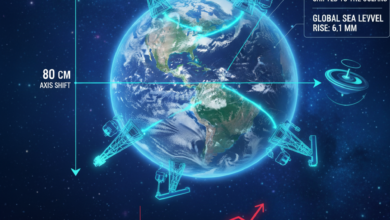Nasa Shares New Images Of The Controversial 3I/Atlas Comet, Closest Observation Taken From Mars

Earth Couldn’t See, But Mars Did: Comet Playing A Key Role In Solar System Discovery Imaged By Multiple Spacecraft
WASHINGTON, USA – The U.S. National Aeronautics and Space Administration (NASA) has released new images containing the closest observations yet of the interstellar comet 3I/ATLAS Comet, a celestial body that has generated significant discussion within the space science community. These new photos and data were compiled from various NASA-supported missions continuing to explore the Solar System.
🔭 MARS’S CRITICAL VANTAGE POINT AND OBSERVATION SUCCESS
When the comet reached its closest approach to the Sun (perihelion) on October 29th, Earth was not in an optimal position for observation. This situation significantly raised the importance of Mars and its orbital assets.
- Tom Statler’s Statement: NASA Planetary Scientist Tom Statler stated, “When the 3I/ATLAS Comet was closest to the Sun, Earth was not in a suitable position to make this observation. However, Mars was on the right side, and our observation tools there could observe the comet.”
- MRO’s Role: The Mars Reconnaissance Orbiter (MRO), which orbits the Red Planet, collected the closest and most critical data on the comet. Furthermore, NASA’s MAVEN orbiter contributed by observing the comet in ultraviolet light, offering details about the hydrogen in 3I/ATLAS’s atmosphere and tails.
- Surface Observation: The Perseverance rover on the Martian surface was also in a perfect position to observe the comet during daylight hours on Mars.

🔬 MULTI-MISSION TRACKING AND NATURAL ORIGIN CONFIRMED
NASA leveraged the opportunity to direct not only its Mars assets but also several other missions to observe the 3I/ATLAS Comet.
- The Observation Fleet: Solar observing spacecraft such as PUNCH, STEREO, and the joint NASA-ESA mission SOHO imaged the comet’s behavior near the Sun. Missions like LUCY and Psyche, which are en route to study asteroid belt targets, also successfully captured images of this rare interstellar visitor.
- Dispelling Controversy: Despite some speculation that the structure of the 3I/ATLAS Comet might be artificial, NASA refuted these claims. NASA stated, “This object is a comet. Its appearance and behavior are comet-like, and all evidence suggests it has a natural origin.” A photo taken by astrophotographer Satoru Murata on November 16, which showed long, impressive tails and a faint green coma, further validated its natural celestial origin.

📅 OBSERVATIONS CONTINUE: DECEMBER 19 ANTICIPATED
NASA will not cease its observations of the 3I/ATLAS Comet. The comet is scheduled to make its closest approach to Earth on December 19th. Therefore, this date will provide the best opportunity for Earth-based telescopes and cameras to capture images, even though the comet will still be quite distant.






